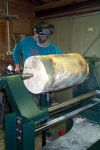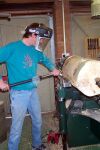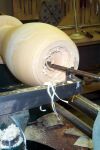I had just bought my new Hegner VB36 lathe and wanted to turn something that would make it work for its living. A large vase in Sycamore was the chosen subject.
I went to our local timber yard and asked for three pieces of wood about 20" in diameter and 29 and a half inches long. I have no chain saw, and any longer than that and it won't go between centres. These were duly chopped up and they charged me £75. In the end, it cost me £85 as I had two bribe two of the burly lads to throw them in the back of my car. I couldn't even roll them across the ground!

  |
Having got the wood home, I found I hadn't got the strength
to get it out! The car looked like someone had stolen the engine because
the weight in the back made the bonnet stand up. |

  |
Tom Neill, my good friend and drinking partner is a handy
man to have around. He weighs twice as much as I do, and has forearms
bigger than my thighs. |

  |
Thanks for the lift, Tom. The three pieces of wood shown
weigh 400lbs. |

  |
It took three of us to get this 147lb lump of Sycamore onto
the VB36. Two to lift it and one to turn the capstan on the tail stock. I
am going to have to get myself an engine lifting hoist! |

  |
First cut is entertaining; the bark was flying all over the
place. The VB36 didn't even twitch. |

  |
First slices start to bring the irregular log into balance |

  |
As it approaches the round and better balance is achieved I
can turn the speed up to 200RPM |

  |
Round, balanced and starting to take shape. Shavings of an
inch wide and a quarter of an inch thick and over eight feet long start
flying through the air. This is as much fun as you can have with your
clothes on. |

  |
Using the long hole boring kit to provide a pilot hole. This
vase will be over 20 inches high, so this is the ideal tool for the job. |

  |
The start of the hollowing process. From the colouration on
the outside, you can see that it has started drying out. I have to get a
move on if I want to avoid the wood splitting. |

  |
The tool rest has a fork for holding the Super Beaver steady
when deep inside the vase. It also acts as a fulcrum so that you can
really put your weight behind it. This makes it much easier to really
hoover out the inside. |

  |
With an opening this big, the contents pour out in ribbons. |

  |
Using the 1 inch ring tool to enlarge the hole started by
the long hole boring tool. The ring tool cuts very well, but you must stop
every two seconds to clear out the debris when you are using it to drill a
hole. |

  |
Overnight, it is important to keep the wood moist to prevent
deformation and splitting. Fill the inside with the shavings you have just
cut out. Lay more of the shavings on sheets of cling film and wrap the
entire vessel. |

  |
The finished vessel. I named this hollow form "Althea" after the goddess of water. Twelve coats of Danish oil and much elbow grease with the 0000 wire wool produced a beautiful lustre to this beautifully figured sycamore vessel.
When I started, the log weighed 147lbs (5 pounds more than me). It now weighs 4lb and produced 8 bin bags of shavings. All the guinea pigs in the local area are very grateful.
|
![]()